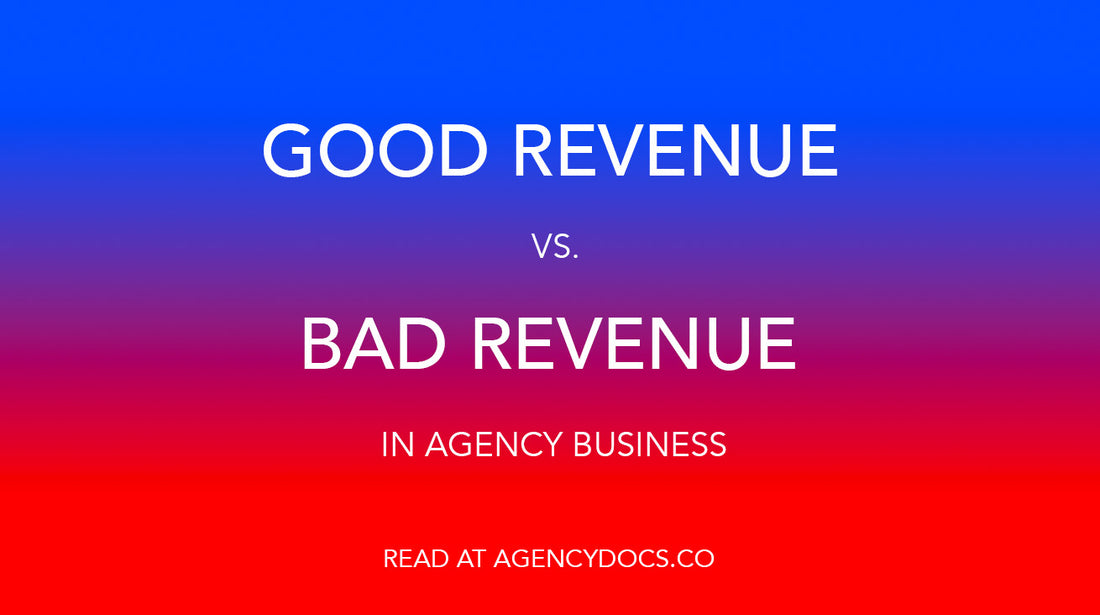Not all revenue is created equal. In fact, there are distinctly good revenue vs. bad revenue when it comes to the agency business.
When growing your agency business, it's very tempting to say yes to all kinds of opportunities as long as the dollars keep rolling in. This is especially the case when the agency is still building its reputation. New business is hard to come by, and therefore, there's pressure to book revenue by pursuing any and all opportunities.
At Barrel, this is a mistake we've made on many occasions throughout our existence. From when we were a 2-person shop to nearly 40 employees, we've faced challenging moments where we felt the pressure to quickly sign new work. We unfortunately handled these situations by aggressively taking on as much work as possible without considering the quality of the opportunity.
Over time, we felt the impact of our decisions as we accepted bad revenue along with good. I would argue that taking on bad revenue set us back years in our growth and development as an agency and put us in perilous positions several times. It's incredibly important for agency business owners to become more discerning about what constitutes good revenue vs. bad revenue and work relentlessly to ensure good revenue dominates the topline.
Defining Good Revenue
One way to define good revenue is to ask: what types of opportunities are likely to help our agency achieve our vision and goals?
From our experience, good client fees come from engagements that:
- Allow the agency to deepen its expertise in a focus area that will continue to grow (e.g. for Barrel, this has been our email marketing services which has been growing)
- Expand your collection of compelling case studies in a certain vertical or service offering (e.g. we've benefitted from our collection of case studies with food & beverage brands)
- Hit the sweet spot of the team's capabilities and proven processes, allowing quality work to be done efficiently (e.g. for us this is design and development work on Shopify websites)
- Strengthen relationship with the client and increase likelihood of additional engagements thereby increasing the client's lifetime value (e.g. our audit and discovery engagements have led to a great deal of follow-on work)
While not explicitly stated, good revenue, by virtue of optimizing for work that can be done efficiently and effectively, usually lead to higher profit margins, which means greater free cash flow and growth for the agency.
Invert for the Bad Revenue
We can extrapolate what bad revenue entails by inverting.
Bad revenue come from engagements that:
- Challenge the agency to learn on the fly and execute something that may be a one-time service offering (e.g. for Barrel, this is working on an unfamiliar content management for the first time on a one-off project)
- Lack case study potential because the client's problem is too niche or the solution is too generic or commoditized (e.g. our web integration work for a client with a proprietary system on an obscure tech stack)
- Require services that don't happen nearly enough for the team to have a repeatable process, causing employees to wrack their brains to get things done (e.g. some of our adjacent work on content production have felt like this while eating into margins)
- Are very prescriptive in nature, with precise directives from the client with little to no input from the agency, turning the relationship into a very transactional one with cost being the primary reason for the client to keep the agency (e.g. our white-label development work for other agencies in our earlier days)
Bad revenue doesn't necessarily mean it's not profitable or bad in the short-term. In fact, many "bad revenue" situations for us were quite lucrative and netted us handsome fees. However, what hurt was the long-term opportunity cost of not investing for the future. Taking on a bad revenue project robbed us of developing better repeatable processes or building compelling case studies that would position us for future growth.
Holding Out for the Future
It's unlikely that an agency can operate with 100% good revenue. There will always be tradeoffs and sometimes the classification between good and bad will be murky. As you come across all kinds of opportunities, you'll develop your own definitions of good vs. bad revenue.
What's important to note is the ratio of good revenue to bad revenue. Can your agency be disciplined and make good revenue the overwhelming majority of the inflows? This means having a vision for where you want the agency to be in the future–the client roster, the service offering, the size of engagements, the team configuration, etc.–and developing strict criteria for new work you take on help realize that vision one engagement at a time. This will sometimes mean forgoing the easy and quick-money gains for something more worthwhile in the future.

